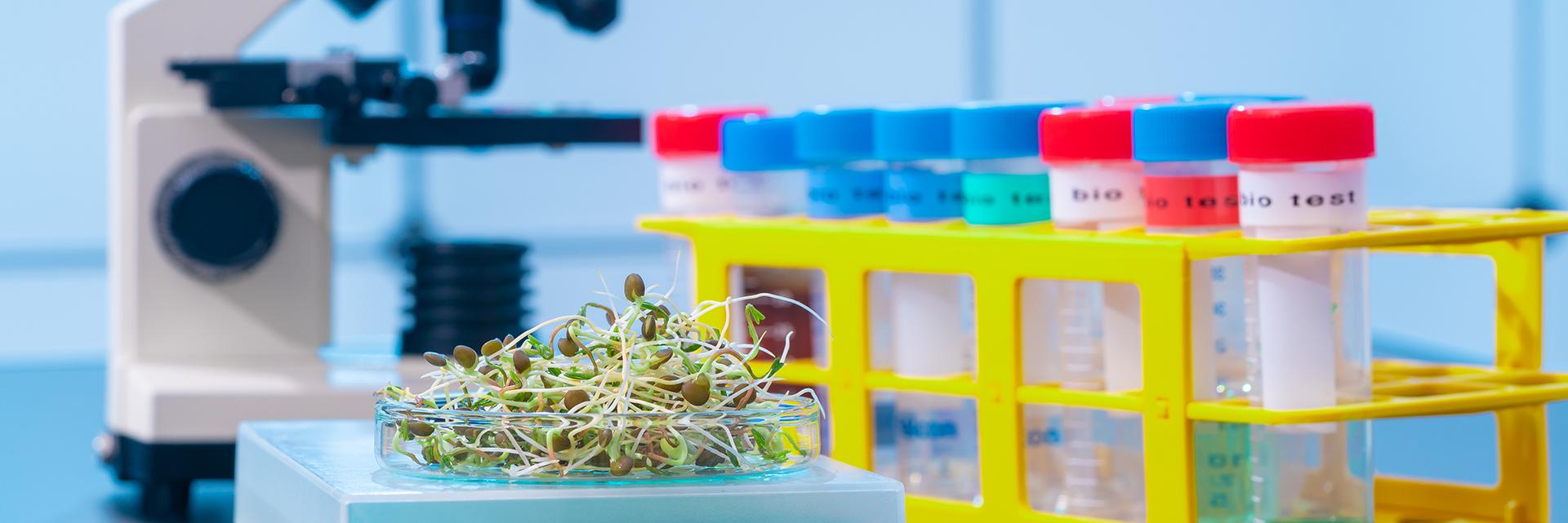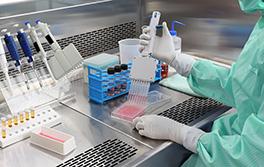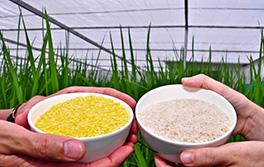Red, white or green
Last updated: 15.11.2022

Biotechnology is primarily used in healthcare and pharmaceuticals, an area commonly known as "red biotechnology". It is also used in industrial processes and manufacturing ("white biotechnology") and to a small but growing extent in agriculture and livestock management ("green biotechnology").
- Red biotechnology: promoting medical progress through patents
-
Advances in the pharmaceutical sector are crucial for the development of medical treatments and drugs that can save lives or improve the quality of life. Today, many breakthrough therapies and medicaments as well as commonly used prescription drugs are based on biotechnology.
One of the earliest biopharmaceuticals was insulin developed on the basis of DNA technology that considerably improved the previously available conventional therapy for patients with diabetes. Over the years many improved forms of biotechnologically manufactured insulin have been developed, and this continuous innovation has been supported by patents.

Other patented medical inventions have provided breakthroughs in DNA fingerprinting, paternity testing and blood transfusions, where patented tests to check donated blood for the presence of deadly viruses have improved patient safety.
Many anti-cancer drugs based on patented human gene sequences are prolonging the lives of cancer patients. Other patented medicaments based on human gene sequences are used to treat autoimmune diseases such as arthritis. Most of the best-selling medicaments are based on biotechnology and covered by patents.

It is enormously expensive and time-consuming to develop a new drug and obtain market approval, and the necessary funds are largely provided by venture capital supplied by investors.
Drug companies would not be able to fund costly research and clinical trials without being able to claim exclusive rights to recoup these investments - in other words without patents. Patents are also an effective barrier to illicit copying of medicines and the health risks associated with unauthorised copycat versions.
The period of protection provided by a patent is limited to 20 years. However, for medicaments authorised by regulatory authorities, a patent right can be extended for a maximum of five further years to offset lengthy clinical trials required prior to market approval. Once the patent has expired, the invention falls into the public domain and can be used by anyone royalty-free. It is the task of national authorities to negotiate lower prices with pharmaceutical companies for medical products, and after a patent has expired, cheaper generic copies may enter the market. Therapeutic, surgical and diagnostic treatments applied to patients are not patentable under the law. This is to ensure that doctors are free to use the best available treatments for the benefit of their patients.

The following sections give more information on important subfields of red biotechnology: immunology, cancer immunotherapy, antibodies and personalised medicine. Many European patent applications in this field contain nucleotide or amino acid sequences that need to be included in the application in the form of a standardised sequence listing.
- Immunology: a rapidly growing subfield of red biotech
-
Immunology is a rapidly developing subfield of red biotechnology. It encompasses new vaccines and antibodies as well as methods to produce them. Between 2015 and 2021, applications to the EPO in the field of biotechnology increased by 30%. In the field of vaccines and antibodies specifically, they increased by 60%, with more than 4 000 applications in 2021.

The introduction of vaccination programmes in the second half of the 20th century has drastically reduced childhood mortality and, together with the advent of antibiotics and improvements in sanitation and education, greatly contributed to increased life expectancy.
Today, vaccines remain the most cost-effective public health strategy, especially for life-threatening infectious diseases. The massive effort prompted by the COVID-19 pandemic resulted in the rapid development of vaccines that saved millions of lives across the world. Examples of the numerous patent applications directed to fighting coronavirus can be found on the EPO's Fighting coronavirus web page, which supports the work of clinicians, scientists and engineers. The recent breakthroughs fuelled by the COVID-19 pandemic will help develop urgently needed vaccines for emerging infectious diseases and hopefully lead to more effective vaccines against difficult-to-prevent and hard-to-treat infections such as malaria and tuberculosis.
- Cancer immunotherapy: how red biotech is fighting back
-
Another dynamic field of vaccine research is the development of vaccines against cancer, of which there are very few. One vaccine helps prevent cervical cancer and was approved for use in Europe in 2006; in 2015 its developers won the Popular Prize at the European Inventor Award. New vaccines are being developed based on the messenger ribonucleic acid (mRNA) technology applied to COVID-19 vaccines. Katalin Karikó, who was one of the main figures behind this technology's development, was awarded the Lifetime achievement prize at the European Inventor Award 2022.
Cancer treatment also benefits from therapy based on the cells of the patient's own immune system. CAR T-cell therapy consists in ex vivo genetically modifying a patient's T cells, which naturally protect the body from infection and cancer. The modified cells produce on their surface an artificial receptor - a chimeric antigen receptor (CAR) - that specifically binds to cancer cells and triggers their destruction. In 2011, a breakthrough was achieved when the complete remission of children with leukaemia was reported. Following repeated successes, CAR T-cell therapy has attracted investments leading to a fast increase in innovation and patenting activity. The EPO has recently published a patent insight report on this technology. Biotech start-up companies are very active in the development of cancer therapies.

- Antibodies: improving diagnosis and treatment of medical conditions
-

Vaccines train the immune system to fight disease via several mechanisms, including the production of antibodies. However, antibodies can also be produced in vitro, and monoclonal antibodies are nowadays widely used in the diagnosis and treatment of various medical conditions ranging from inflammatory and autoimmune diseases to cancer, graft-versus-host disease and transplant rejection. They are the fastest-growing class of biopharmaceutical drug and in 2021 the market for therapeutic antibodies exceeded USD 180.5 billion. Therapies using antibodies are also used in veterinary medicine.
- Personalised medicine: customising therapy to each patient
-
Besides therapeutic applications, red biotechnology also encompasses the identification of new genetic markers for diseases. An ever-increasing set of genetic markers enables the definition not only of susceptibility to diseases but also of new subsets of diseases with specific characteristics such as prognosis and susceptibility to treatment. This information makes it possible to tailor treatments optimally to the needs of an individual patient. Such personalised medicine avoids the side effects of ineffective treatments, and for society it saves the costs of unnecessary therapies.
The EPO has a specific webpage relating to various technologies and inventions in the field of personalised medicine.

- White biotech: increasing the efficiency of industrial processes through innovation
-
White biotechnology is the use of micro-organisms - bacteria, yeast and fungi - in chemical production systems. The living cells are used to produce enzymes which in turn can be used in numerous industrial processes, such as the production of detergents, pulp and paper, textiles and biomass.
Advances have also propelled the development of technologies to produce biofuels, such as methane, ethanol and butanol, and electric energy from renewable sources. Micro-organisms have been engineered to produce fuels purely using biotechnology, and numerous advances have been made to maximise production of fuels from cheap and widely available sources, such as waste streams from industry, agriculture and forestry, municipal solid waste, waste water, algae and waste gases.
White biotechnology also helps reduce waste by providing new biodegradable plastics, for example from plants and fungi. An EPO study from 2021 illustrates the key role played by patents for innovation in this area.

The performance fibres made of spider silk invented by 2018 European Inventor Award finalist Thomas Scheibel are one of the many examples of groundbreaking white biotechnology inventions.
- Green biotech: encouraging more sustainable agriculture and ensuring food security
-
Biotechnology has numerous useful applications in agriculture, including the provision of genetically altered plants and the manipulation and use of micro-organisms to obtain favourable plant characteristics. Examples include plants with greater resistance to pests or to environmental factors including heat, salinity and drought, that have a higher yield or more nutrients, or whose cultivation requires fewer resources such as water, fertiliser or pesticides.
In a study from 2021, the European Commission estimated that plants and plant products with altered genetic material are a key contributor to the objectives of the EU's Green Deal, and in particular to the "farm-to-fork" and biodiversity strategies, and to the United Nations' Sustainable Development Goals for a more resilient and sustainable agri-food system.
Biotechnology also provides new technologies, for example embryo preservation, to conserve biodiversity and save endangered animal and plant species. By maintaining biodiversity on land and in the sea, biotechnology helps reduce the impact of climate change.
In addition, green biotechnology supports the development of new food with added nutritive value. It promotes the use of protein from non-animal and non-mammalian sources (e.g. insects) and uses probiotics to promote health.
See our fact sheet on plant patents for more information.
